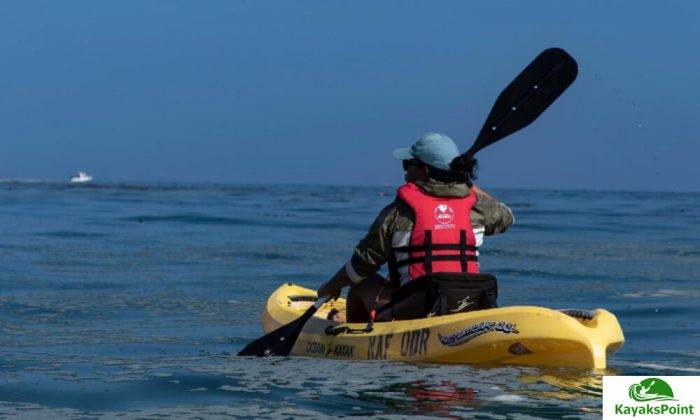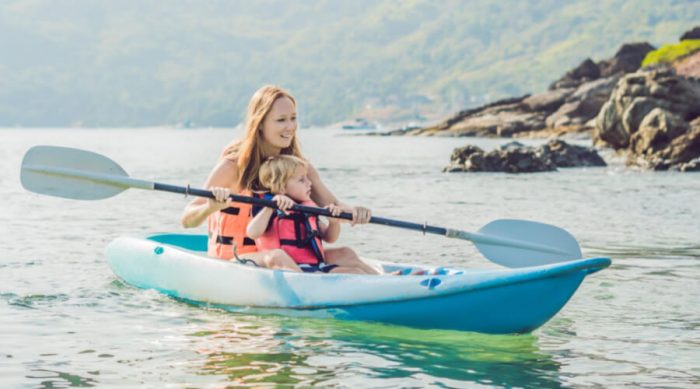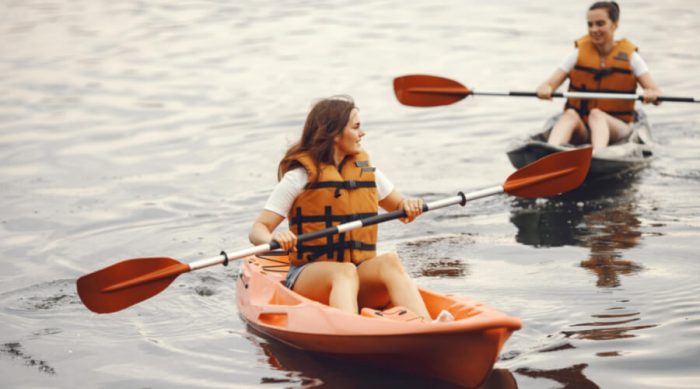Some beginners perceive kayaking to be difficult, but in reality, a bit of experience is all you need to ace it. The water body, the kayak, the paddle, and the weather condition are the factors that determine how hard it can be.
Key Takeaways
- How difficult kayaking can be for you will depend on the level of your experience and your physical endurance
- Kayaking is a type of sport that includes a lot of fun activities like exploring, sightseeing, and fishing as well as exercising
- If you are a beginner kayaker then a sit-on-top kayak will be the best option for you
- Paddling is one of the most significant parts of kayaking and the shape of the paddle plays a very important role in how quickly you will become tired

What Are Kayaks?
North American Inuits were the first people to build kayaks. In the early days, the structure of the kayak was made with the bone of a whale. The covering was leakage-proof with the skin of a seal or any other animal. The kayak was thus buoyant and airtight.
Nowadays, people use materials like plastic, wood, Kevlar, and fiberglass to make kayaks.
What Kind Of Kayak Do You Need?
There are different types of kayaks with various lengths and widths. Some are long, short, narrow, and wide. The kind of kayak you choose will depend on your use. The most common ones are recreational, whitewater, racing, surfing, touring, flat-water, and sea kayaks.
A kayak that is wide provides more stability, which is important for a beginner. Short and wide recreational kayaks offer more maneuverability. Although the long and narrow kayaks are faster, they displace more water than the shorter ones. It requires the kayaker to put in more effort, which can be difficult for the learner.
The best choice for the beginner is a sit-on-top kayak. Their structure is made from fiberglass, which gives them greater durability and lighter weight. It is relatively easy to get off and on in a sit-on-top kayak. They are more stable and paddling them can be done without much difficulty. Its chances of capsizing are comparatively less.
How To Kayak?

Paddling is one of the most significant parts of kayaking. That is why we must invest in good-quality pedals. Cheap and low-quality pedals will cause you more fatigue. It would help if you chose the right pedal depending on your height, kayak size, and strokes. If you have a small stature, you can opt for a lightweight and short paddle. Wide and tall kayaks need a longer paddle. The blades also have various kinds of sizes and shapes. Narrow blades need very little effort but a greater number of strokes. You can accelerate more with wide blades, but you can experience resistance while you stroke which can make you tired. The shape of the paddles also varies from curved to flat. The flat paddles are cheaper than the curved ones. But, the latter works more efficiently for enhancing your strokes. Feathered blades lessen resistance to the wind.
While you are kayaking, you can avoid overexertion by turning your torso towards the direction of each stroke that you make. We must do the same when turning the kayak by dragging the paddle on that size. A sweeping stroke can also benefit you by keeping control of your momentum. That can save you a lot of energy. Sitting straight will allow you to make faster strokes. You have to keep your elbows at a right angle as you raise your paddle. Your left and right hand must be in alignment. Keep your toes on the footpegs out and to the center. Core strength is also very important during kayaking. Another challenge that beginners face is getting off and on. To overcome this difficulty, you must maintain your weight centered and low.
Can I Go Alone, Kayaking?
The first thing you need to consider is whether you want a single or a tandem kayak. If you have a friend with whom you can sync your strokes, you can go for a tandem kayak. When you are out kayaking for the first time, you must take an experienced kayaker, guide, and friends. That is because you can face problems like losing paddles and capsizing. In such scenarios, an experienced kayaker can guide you.
Instead of buying a kayak right away, you can borrow one from a friend if you are a beginner. You can also rent one from rental shops or touring companies.
Can I Capsize?
Beginners must choose calm rivers and lakes for kayaking. That will cut down the chances of capsizing. You can also stay near the shore in case the worst happens. Paying attention to the weather to avoid storms can also help you in this regard. It would help if you also kept your weight balanced while getting in or out to protect yourself from any mishaps.
What Safety Precautions Can I Take During Kayaking?

A life jacket is a must-have while kayaking. Children whose age is under 16 have to carry it. Even if you are an adult, you must take them with you for safety reasons. Here, you can opt for light jackets with big openings in the arms that help you move with ease. A good helmet will keep you safe when you are out kayaking in rocky waters.
Splashing is also unavoidable during kayaking. That is why you can opt for a bilge pump or a spray skirt. You can also keep a dry bag to protect your belongings like cell phones, accessories, and wallets. Protecting yourself by wearing kayaking gloves and a wetsuit will save you from a lot of trouble. You can also bring some spare clothes if the need arises.
References:
- https://www.quora.com/How-hard-is-kayaking
- https://threesisterskayakrental.com/is-it-difficult-to-kayak/
- https://lakelandkayaks.ie/blogs/news/is-kayaking-difficult-for-beginners

Rockey is a kayaking enthusiast who has been kayaking with a local group for the last five years. He loves using kayaks while out on outings on the water or camping when the friends want to have a BBQ party somewhere on the bank of a local lake. More About James R Rockey at About Page Here: Authors
Based on his experiences with the different types of kayaks, he is sharing his opinion about kayaking tricks and required gears so that a beginner can get started right away.
Find his team on Twitter here. Happy reading!
